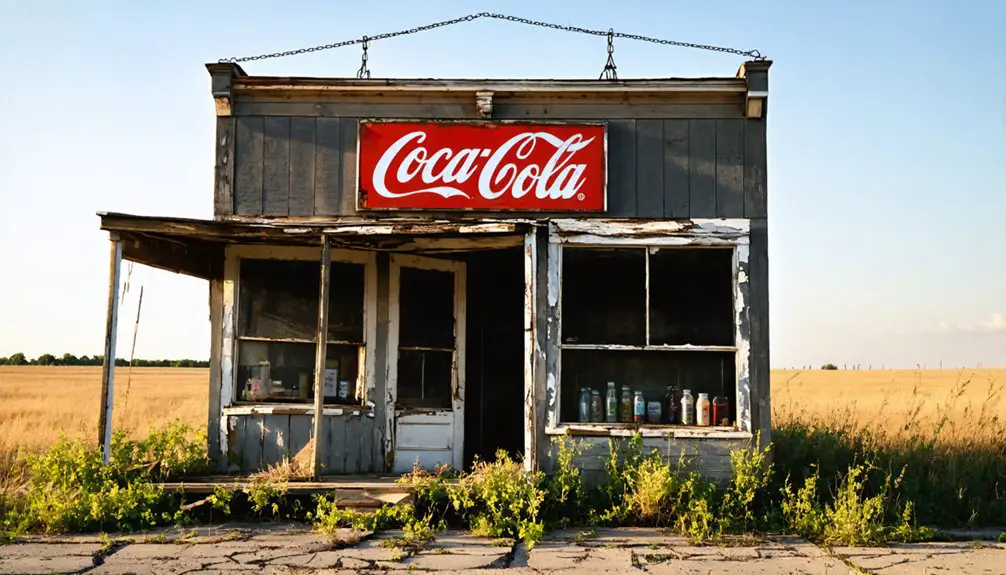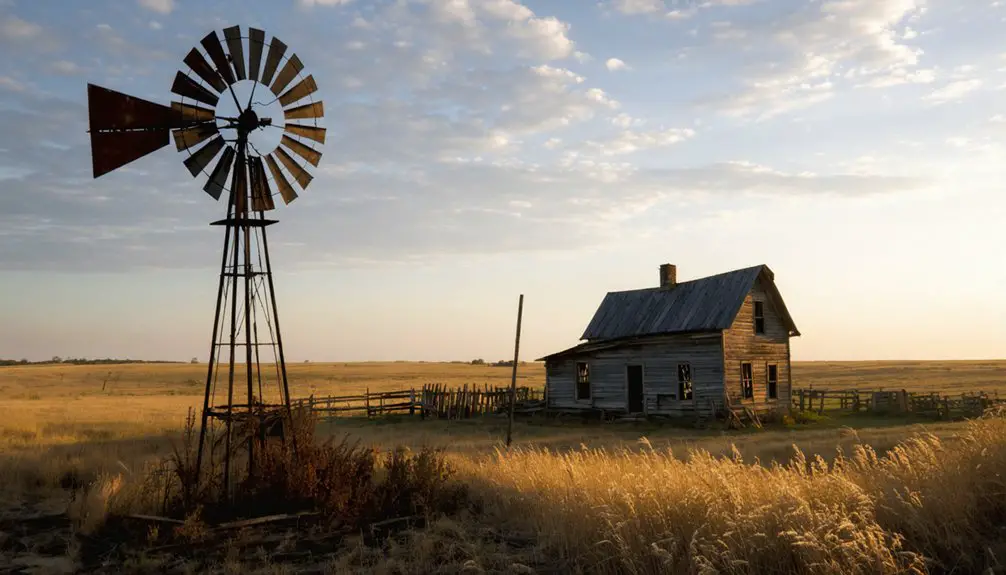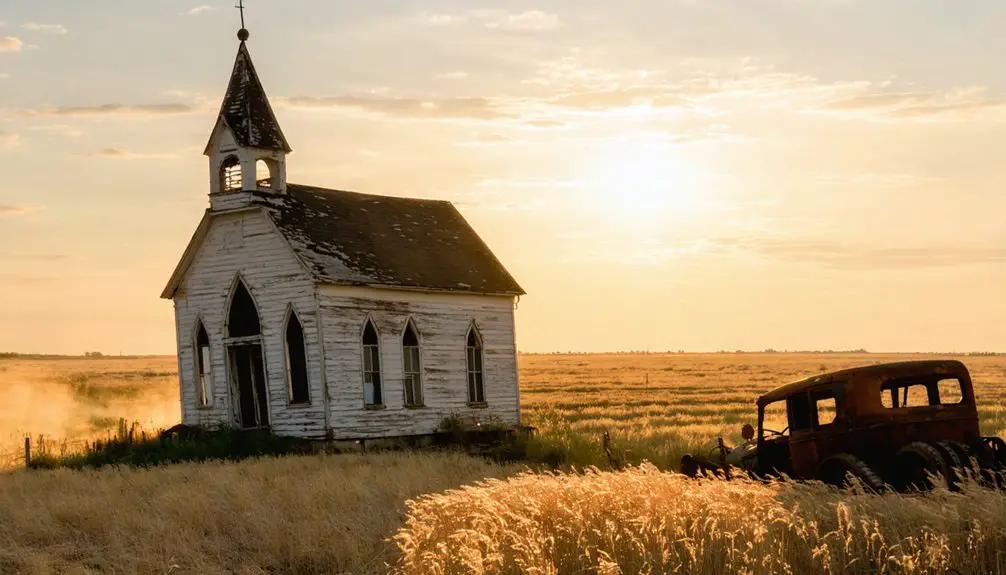You’ll find Pleasant Plains, Kansas as a ghost town that began as an 1875 agricultural settlement near Little Medicine Creek. The community’s post office operated from 1878 until 1904, with the town changing its name to Deliverance in 1894. Early settlers faced typical prairie challenges, building dugouts and sod houses while establishing farms and ranches. The town’s decline mirrors many Kansas settlements, where transportation difficulties and rural delivery changes transformed frontier communities.
Key Takeaways
- Established in 1875, Pleasant Plains began as a frontier settlement with a post office and attracted homesteaders seeking agricultural opportunities.
- The town changed its name to Deliverance in 1894, marking a significant shift in community identity during economic hardships.
- The community centered around Little Medicine Creek, sustaining itself through small-scale farming and cattle ranching activities.
- Pleasant Plains’ post office closed in 1904, signaling the town’s decline as residents began relying on neighboring communities for services.
- Economic challenges led to population loss and abandonment, leaving only physical remnants like empty storefronts and weathered farmhouses.
The Birth of Pleasant Plain Settlement
When settlers officially established Pleasant Plain in 1875 by filing the town’s first plat and post office application, they joined the broader movement of western expansion sweeping across Kansas in the late 19th century.
The frontier settlement attracted homesteaders from eastern states, including Civil War veterans seeking new opportunities in agriculture and business.
You’ll find that these early residents faced significant settlement challenges typical of prairie life. They built dugouts and sod houses due to limited timber resources, while adapting to the harsh environment. Like other prairie settlements of the era, a measles outbreak swept through the community, affecting many early residents. Similar to Iowaville, few remnants of the original settlement remain visible today.
Early agriculture became the backbone of Pleasant Plain’s economy, though settlers contended with unpredictable food supplies as game animals migrated across the territory.
Despite agriculture anchoring Pleasant Plain’s economy, pioneer families struggled with uncertain food sources as wildlife patterns shifted across Kansas.
The town’s strategic location near existing emigrant and military trails helped facilitate crucial trade and communication with other settlements.
From Pleasant Plain to Deliverance: A Name Change
You’ll find that Pleasant Plain’s identity underwent a significant transformation in 1894 when its post office officially changed names to Deliverance.
Much like General Custer’s staff who had to hastily gather supplies for their journey south, the town’s transition happened rather quickly. The name change marked a pivotal moment in the settlement’s history, though records don’t specify the exact reasons behind choosing “Deliverance” as the new designation. The name would later gain new cultural significance when the 1972 film Deliverance became a major box office success.
This formal alteration would only last a decade, as the post office ceased operations entirely in 1904, foreshadowing the community’s eventual decline into ghost town status.
Post Office Name Change
During the town’s operational years, the Pleasant Plain post office underwent a significant name change to become known as Deliverance, reflecting broader changes common in evolving Kansas settlements. This postal history transformation required formal petitions and legislative approval, documented in Congressional records.
You’ll find the change wasn’t merely administrative – it impacted the entire community’s identity and mail delivery system.
The process involved coordination with USPS regional offices, updating maps, and revising mail routes to prevent delivery errors. This community transformation meant residents and businesses had to adapt their mailing addresses, while postal workers adjusted their routing procedures.
The change symbolized deeper shifts in the town’s development, joining countless other Kansas settlements that underwent similar evolutions in their quest for distinction and efficient mail service. The transition occurred during a period of unprecedented volume increases, creating additional challenges for the postal system.
Town Identity Evolution
The evolution from Pleasant Plain to Deliverance marked more than just a postal designation – it reflected profound changes in the community’s self-identity.
You’ll find that this 1894 transformation showed remarkable community resilience during challenging times, as the town shifted from a name describing its peaceful landscape to one embodying hope and salvation.
This cultural transformation coincided with religious revival movements sweeping through Kansas, suggesting the influence of spiritual aspirations on the town’s collective identity.
While Pleasant Plain had emphasized the settlement’s geographic context near Little Medicine Creek, Deliverance expressed deeper theological meaning.
The name change came during a period when the small community of just 20 residents faced economic hardships, perhaps seeing their new identity as a symbol of potential redemption.
Life Around Little Medicine Creek
Life around Little Medicine Creek centered on agricultural subsistence, with settlers strategically establishing homesteads near this tributary of the South Solomon River in eastern Rooks County, Kansas.
Pioneers built their homesteads along Little Medicine Creek, making strategic use of this Kansas waterway for agricultural survival.
You’ll find settler stories reflecting the diverse backgrounds of Pennsylvania, Ohio, Iowa, and Missouri families who claimed this fertile bottomland, alongside Canadian French Catholics who made their way through Illinois.
The creek’s resources proved crucial for your typical homesteader’s survival, providing irrigation for crops and water for livestock. The early settlers who arrived in 1871 and 1872 focused primarily on establishing successful livestock operations in the area.
The area gained historical significance as Native American tribes previously used these lands for buffalo hunting grounds before being displaced by treaties and settlement.
Agricultural practices evolved as farmers expanded their holdings, particularly favoring the rich creek bottomlands for cultivation.
You’d see a mix of small-scale farming and cattle ranching operations, with families trading goods and services among themselves to sustain their community of roughly 20 residents by 1910.
The Post Office Era: 1878-1904
You’ll find postal records showing Pleasant Plains’ post office establishment in 1878 marked a significant milestone for the rural Kansas settlement’s development.
Like many lost Kansas communities, Pleasant Plains served as a stopping point for travelers along stagecoach routes through the territory.
The post office, operating under its original name throughout its 26-year run, served as an essential communications hub for area farmers and families during the region’s peak settlement period.
When Rural Free Delivery routes expanded across Kansas in the early 1900s, Pleasant Plains’ post office operations ceased in 1904, reflecting the broader pattern of small post office closures throughout the state.
Early Mail Service Origins
During Pleasant Plains’ early development, mail service emerged as an essential lifeline when the U.S. Post Office Department established a local office in 1878.
You’ll find that mail routes connected settlers through horse-and-rider delivery systems, fostering significant community connections during Kansas’ formative settlement period.
- Riders traversing weather-beaten trails, carrying saddlebags filled with letters and news from distant family
- Postmasters sorting mail by candlelight in small wooden buildings that doubled as gathering spots
- Horse hooves kicking up dust on winding prairie paths as carriers delivered weekly dispatches
- Settlers keenly awaiting mail delivery, forming clusters of conversation outside the post office
The establishment of Pleasant Plains’ post office reflected America’s broader push to expand rural mail access after the Civil War, serving as a pivotal communication hub for pioneering families forging new lives on the Kansas frontier.
Name Change Impact Analysis
As Pleasant Plains joined other Kansas post offices in conforming to national standardization efforts, its postal identity underwent significant administrative changes between 1878 and 1904. You’ll find evidence of name standardization through postal records using specific codes like (T:) for changes and (S:) for service transfers, reflecting the broader reforms sweeping across Kansas during this period.
The community faced adaptation challenges as the postal board implemented changes, including the elimination of possessive forms by December 1894 and the replacement of “Centre” with “Center” by December 1893. Historical records from Baughman’s post office list provided vital documentation of these transitions.
These modifications affected local business correspondence and community identity, while postmasters worked to maintain smooth mail operations. Through careful documentation and standardized coding systems, you can trace how Pleasant Plains’ post office navigated these administrative reforms while preserving essential mail services.
Final Years of Operation
While the Pleasant Plains post office initially thrived after its 1878 establishment, the operation faced mounting challenges throughout the 1890s that ultimately led to its closure in 1904.
You’ll find that the postal service impact extended far beyond mail delivery, as it represented the community’s connection to the wider world. The final years saw declining mail volumes and administrative changes that reflected the area’s diminishing prominence.
- Mail carriers traversing dusty Kansas roads with satchels full of letters and packages
- Local farmers gathering at the post office, exchanging news while collecting their correspondence
- Postmasters meticulously sorting mail by candlelight in the evening hours
- Horse-drawn wagons departing with outbound mail, connecting Pleasant Plains to distant cities
The discontinuation forced residents to rely on neighboring towns for postal services, marking a significant shift in local commerce and communication patterns.
Transportation and Economic Challenges
Because railroad access proved crucial to town survival in Nemaha County between 1867-1870, Pleasant Plains’ ultimate fate hinged on its transportation connections.
Like many paper towns that failed to thrive, Pleasant Plains struggled to maintain its population and economic viability.
Without a rail stop, you’d have seen the town’s businesses – from stores and hotels to sawmills and blacksmith shops – quickly shut their doors. The transportation challenges intensified as the town lost crucial freight routes that once connected it to economic hubs in Denver and Utah.
The economic decline accelerated when the Rural Free Delivery system emerged in the early 1900s, making the local post office less relevant.
You’ll find that Pleasant Plains’ isolation grew worse as roads deteriorated and transport logistics became more complicated. Without the crucial rail link, the town couldn’t sustain its commercial activities, and residents moved to rail-connected communities or returned to farming.
Population Decline and Abandonment

The economic and transportation hardships that plagued Pleasant Plains set off a devastating chain of population losses that would eventually seal the town’s fate.
Like many Kansas small towns, Pleasant Plains experienced a declining population that started in the early 20th century and accelerated through the decades.
You’ll find that the town’s community abandonment followed familiar patterns, with younger residents departing for opportunities elsewhere, leaving an aging population behind.
- Empty storefronts stand silent along Main Street, windows boarded and paint peeling
- Weathered farmhouses dot the landscape, their porches sagging from neglect
- The old schoolhouse bell tower remains, though children’s voices no longer echo
- Overgrown yards surround vacant homes, nature slowly reclaiming the land
These physical remnants tell the story of a once-thriving community that gradually faded into Kansas’s growing collection of ghost towns.
Historical Significance in Osborne County
Located near the head of Little Medicine Creek in Osborne County, Pleasant Plains emerged as a notable settlement during Kansas’s frontier development period.
You’ll find its historical significance deeply woven into the county’s pioneering narrative, marked by the establishment of its post office in 1878 and its intriguing name change to Deliverance in 1894.
While historical preservation efforts have faced challenges due to limited documentation, the community’s role in regional development can’t be overlooked.
Despite gaps in records, Pleasant Plains remains a vital piece in understanding the broader story of regional settlement and growth.
As part of Osborne County’s early growth, Pleasant Plains represented the determination of frontier settlers adapting to rural life.
Today, community memory of this ghost town serves as a reflection of the dynamic nature of settlement patterns in north-central Kansas, reflecting both the opportunities and challenges that shaped the region’s identity.
Legacy and Modern-Day Ghost Town Status

Despite its promising start in 1875, Pleasant Plains gradually evolved from a vibrant community into a ghost town through several defining changes.
The town’s community legacy unfolded through the closure of its high school, churches, and post office, while the rise of automobile transport drew residents to larger centers.
When local oil wells depleted and the town plat was legally vacated in 1928, Pleasant Plains’ shift to farmland became complete.
- Crumbling foundations peek through tall prairie grass where bustling shops once stood
- Weathered gravestones tell silent stories of the town’s former inhabitants
- Empty fields stretch across what was once a grid of active streets and homes
- Farm equipment now traverses land that previously hosted church socials and school activities
Frequently Asked Questions
What Native American Tribes Originally Inhabited the Pleasant Plain Area?
You’ll find the Kanza tribe primarily inhabited your Pleasant Plains area, while the Osage, Pawnee, Comanche, and Wichita Native tribes shared historical significance through hunting grounds and settlements nearby.
Were There Any Notable Crimes or Lawlessness in Pleasant Plain?
Like a blank page in history’s book, you won’t find any documented crime history or notable law enforcement incidents in this town. Research shows it maintained peaceful order until its decline.
What Happened to the Buildings and Materials After Abandonment?
You’ll find that building decay led to systematic dismantling, with materials being repurposed for nearby farms. Locals salvaged usable components while remaining structures naturally deteriorated and the land converted to agriculture.
Did Any Famous Historical Figures Ever Visit Pleasant Plain?
Like footprints in untouched snow, you won’t find any traces of historical visits or notable guests in Pleasant Plain – records show no famous figures ever graced this small farming community’s streets.
What Types of Businesses and Industries Operated in Pleasant Plain?
You’d find agricultural practices dominated the economy, with local commerce including general stores, grist mills, livery stables, blacksmith shops, hotels, and oil wells supporting farming and railroad-related activities.
References
- http://www.kansasheritage.org/werner/gostnmco.html
- https://www.youtube.com/watch?v=VPZtNoncnig
- https://en.wikipedia.org/wiki/Deliverance
- https://legendsofkansas.com/kansas-ghost-town-list/
- https://en.wikipedia.org/wiki/List_of_ghost_towns_in_Kansas
- https://savingplaces.org/stories/discover-the-kansas-town-settled-by-black-homesteaders-in-the-1870s
- https://www.youtube.com/watch?v=OyBXD18P_j4
- https://theclio.com/entry/171695
- https://digitalcommons.usu.edu/context/mormonhistory/article/1055/viewcontent/JMH_Summer_2008.pdf
- https://www.gutenberg.org/files/40731/40731-h/40731-h.htm



